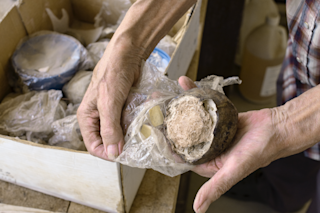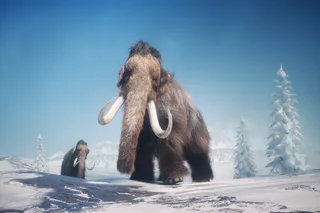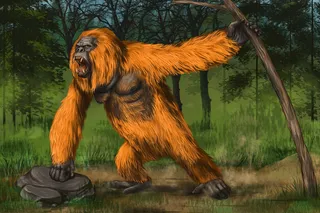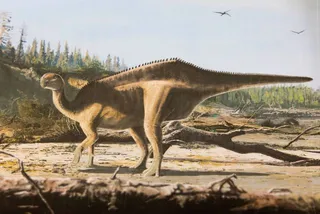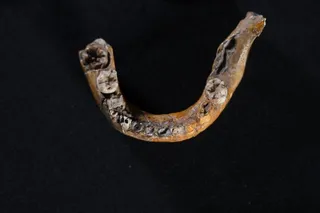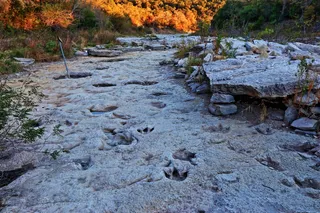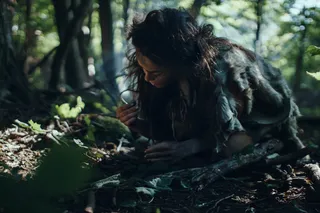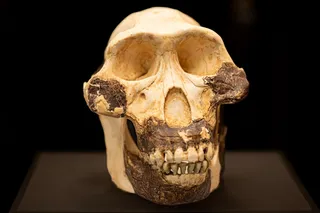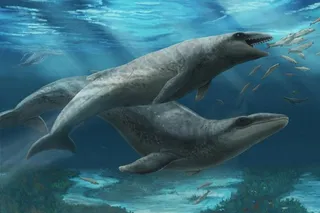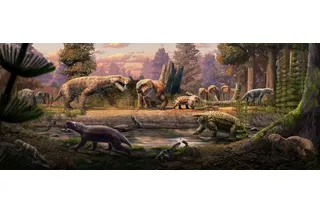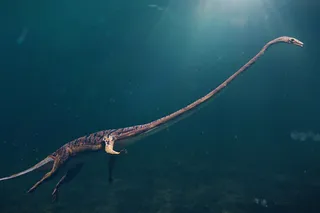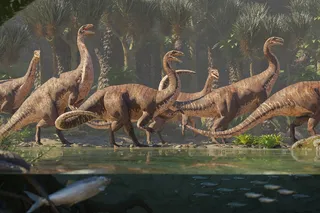This article appeared in our March/April 2022 issue as "Waiting to Hatch." Become a subscriber for unlimited access to our archive.
His days would start promptly, like a banker’s — except he also worked weekends. At 8:30 each morning, Terry Manning would step outside his two-story brick house on Gipsy Lane in Leicester, England, walk through the yard, let himself in the house next door, climb the stairs and take a seat at his workbench, with a view onto the garden out back.
There he sat for the next nine hours or so, surrounded by dozens of sand-colored eggs ranging in size from 1½ to 20 inches long. Soaking in plastic bowls of acid, these eggs were originally laid some 75 million to 85 million years ago by dinosaurs living in what is now China. Manning would break from his station around 5:30 p.m., head downstairs, watch the news and eat, maybe take a nap. Then he’d trudge back up the steps for a few more hours at the microscope. Finally, around 9:30 p.m., it was off for a pint and glass of tequila at the local pub, Swan & Rushes.
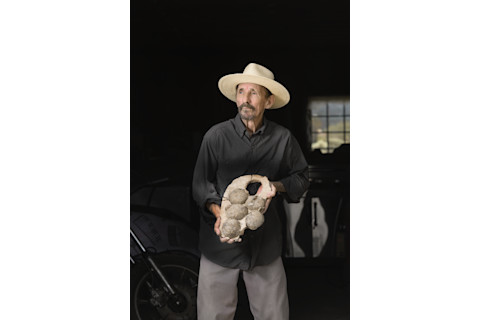
Inside his home and garage in Tucson, Arizona, Terry Manning keeps dinosaur eggs by the box full. This clutch from a therizinosaurus is roughly 70 million years old. (Credit: Mark Peterman)
Mark Peterman
This routine defined Manning’s life for the better part of a decade, starting in 1993. Along the way, he sorted through at least 3,100 eggs from the Henan province of China, sold most of them to fund his ongoing work, and kept about a third, guessing they might contain what he was really after: dinosaur embryos. At the end of it all, the self-taught fossil technician had developed his own technique for uncovering embryos, using acetic acid, resin, wax and other materials. He now claims an unrivaled collection of nearly three dozen eggs revealing unborn dinosaurs, which is unique in its own right and even more remarkable given his lack of scientific training or any institutional oversight. “Basically,” Manning says, “everything I’ve learned was from books.”
When his first specimens surfaced in the early ’90s, they were “revolutionary,” says Jeff Liston, president of the European Association of Vertebrate Palaeontologists. Manning had revealed dinosaur embryo skeletons and what may be soft tissues such as cartilage, both of which are exceedingly rare in paleontological research. Yet nearly 30 years later, only about half of Manning’s collection has ever appeared in public, at a single exhibit in 1995. Beyond that, just a few scientists have been able to publish research on some of the eggs — producing novel findings.
“[It’s] almost like a legend or a myth,” Liston says of Manning’s work. A unique series of circumstances have barred the specimens from wider research, public viewing and recognition. This includes international laws and politics, academic suspicions about outsiders in science and the multimillion-dollar price tags Manning has placed on his eggs, according to scientists and museum officials who have followed his work for decades.
None of that changes the potential answers they hold for the field of paleontology. Renowned paleontologist Luis Chiappe, who works as the head of research and collections at the Natural History Museum of Los Angeles County, says that if the collection were made public, it would be “like discovering five new paintings by Leonardo da Vinci in a false wall in a house somewhere in Europe.” But since 2010, 33 of Manning’s best specimens of dinosaur eggs and embryos have been locked in a safe on a retired banker’s country estate in Sussex, England.
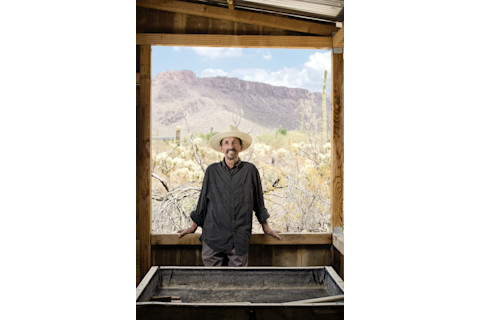
Manning opts for off-the-grid living on his ranch in Tucson, forgoing regular internet use and a personal cellphone. (Credit: Mark Peterman)
Mark Peterman
Dissolving the Past
Growing up in Plymouth, England, Manning kept to himself and read prodigiously. “I was a loner. I never had friends,” he says. “I could recite the Encyclopedia Britannica from back to front.”
By the time he reached age 12, he says, he was correcting the teachers; and at 17, he donned a kilt and set off to hitchhike across Europe, a defining step in his unconventional life to come. Over the next few decades, Manning made jewelry and bought and sold gems, minerals and fossils, mostly in England, Germany, Russia and the U.S.
In 1985, he was working at a museum in Moscow when he encountered a group of dinosaur eggs that had been dug up in Mongolia. He peered through the cracks in one shell, and had a vision. “Through the hole, inside the egg, I saw calcite,” he says. He knew the mineral came from hard water, and that it attaches itself to bones and preserves them: “If I could find dinosaur eggs that were laid in areas with shallow, mineral-rich groundwater, the calcite in the water would have helped preserve the bones of the embryos.” All he had to do was find the right eggs and dissolve enough shell and surrounding material without destroying the embryos — something no one else had done before.
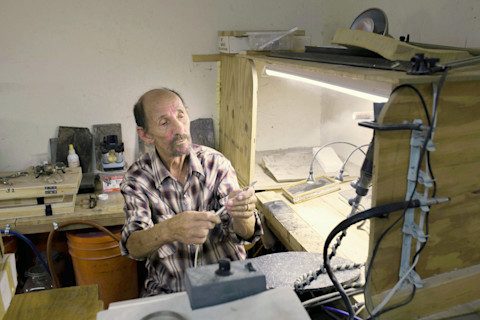
Manning maintains a humble work station at his home, where he processes fossils for museum projects. (Credit: Mark Peterman)
Mark Peterman
Manning put the word out to fossil dealers. But it wasn’t until 1992 that he got a call from Peter Woo, a business partner in prior deals. “I got a batch of eggs,” Woo said. Just before the new year, Manning flew from Manchester to San Francisco to see what Woo had brought back from a recent trip to China’s Henan province. It didn’t take him long to conclude that his partner was onto something. Manning sent Woo back to Henan to buy what he could. The dinosaur egg fossils were so plentiful that farmers there treated them as rocks, using them in their stone walls. Over the course of almost a year, Woo bought 3,100.
Back in Leicester, Manning began what would become his decade-long routine in his workshop on Gipsy Lane, refining his technique on whatever Woo could find. Scientists had used acetic acid to dissolve rock surrounding vertebrate fossils since the 1930s. So Manning experimented with various concentrations and other materials to slowly dissolve enough of the dinosaur eggshells to see inside — at a mind-numbing rate of about 1/2000 of an inch per day. If the eggs appeared to contain promise, he would dissolve the silt and stone covering the delicate bones of the embryos. On a good day, he could remove 1 teaspoon of silt from around the embryo he was working on. He created a Rube Goldberg-esque setup, with bowls for the eggs, tubes running from water faucets and airbrushes spraying stabilizing solutions on the bones.
Decades later, speaking on the phone from his current home in Tucson, Arizona, he says, “I loved it. The only time I stopped [working] was about half past 5:00.” It took about four months of this daily routine in Leicester for Manning to uncover his first embryo.
Praise and Purgatory
The big reveal of Manning’s work, at the Cambridge University Museum of Zoology, earned a review in the March 24, 1995, issue of the journal Science. The writer called the exhibition “stunning,” and reported that it was “leaving many paleontologists breathless with excitement.”
Manning had produced nearly two dozen specimens and the enthusiastic support of a small group of paleontologists — enough to launch the event, with a booklet titled “The Dinosaur Egg & Embryo Project.” The Science article notes that the 20 specimens included an egg containing “the most complete set of bones” ever seen of a therizinosaur, a little-known group of dinosaurs, and a pond tortoise embryo that appeared to push back the dating of this species from 40 million to at least 65 million years ago.
Along with praise, the article also forecast what would become decades of barriers blocking Manning’s work from greater exposure. The second paragraph grimly notes that the “academic excitement” was “tempered with concern.” The list of concerns: Manning and his partners were private collectors and had bought the eggs without the documentation of a scientific expedition or collection site. They were also using the exhibition to attract a potential private buyer, one they hoped would donate the specimens to a public museum. The price tag was $6 million, enough to acquire the specimens and pay for Manning’s continued work on additional dinosaur eggs, according to the article. “Such a deal might ‘lend scientific credibility to what is essentially a commercial exercise,’ ” paleobiologist David Unwin, then at the University of Bristol, told the Science reporter.
These concerns about muddying science’s intellectual purity due to commercial interests stalled legitimate research on the eggs and embryos. That’s because when museums don’t accept and catalog specimens with what’s known as an accession number, they cannot be used for scientific research in reviewed and respected journals. So, in Manning’s case, keeping the collection in his hands would block any credible discoveries. Nonetheless, another geologist told the reporter, “there’s no question of the fantastic scientific importance of these embryos … [but] my personal attitude is, ‘don’t touch them with a bargepole.’ ”
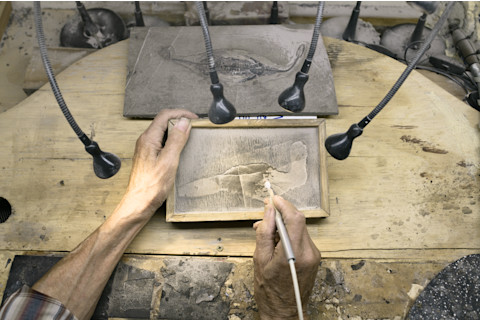
These gray slabs in Manning’s workshop hold fossils of keichousaurus marine reptiles, which lived in the Triassic period, more than 200 million years ago. (Credit: Mark Peterman)
Mark Peterman
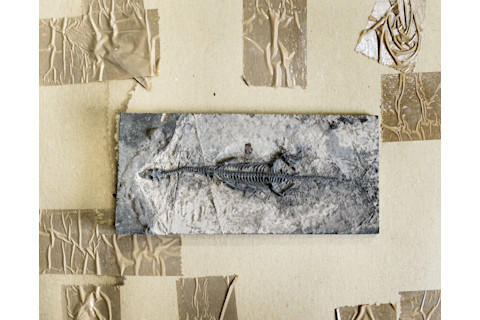
Liston, an early supporter of Manning’s work, would go on to write a paper published in 2013 about another obstacle facing the eggs and embryos. Before the exhibition, the Chinese government passed a law reclassifying dinosaur eggs from “trace fossils” to “vertebrate fossils.” This means they went from bearing “evidence of an animal … [to] the animal itself — a major reclassification,” according to John Nudds, one of the few scientists to publish research on Manning’s work. This distinction essentially made it illegal to remove dinosaur eggs from the country.
Even though all 3,100 of the eggs that Manning evaluated left China before this law was passed, the possibility of what Liston called “forced repatriation” cast another shadow over the work, making it even less likely that any museum or other public institution would acquire and display the specimens. The end result, wrote Liston: “This fantastic research resource was in academic limbo — the paleontological equivalent of film projects lost in Hollywood’s ‘development hell’: Everybody knew they were there, but nobody could publish on them.”
Despite these shadows, the 1995 exhibition proved so popular that Cambridge extended the originally scheduled one-month run to nine months. After it closed, the “Dinosaur Egg & Embryo Project” would never again be seen in public.
Embryos for Sale
Amidst this controversy, in 1998, Manning met the scientist who would become his unbending ally. “[Manning] rang me at work,” recalls Nudds, referring to the Manchester University Museum, where he was keeper of geology for 15 years. The museum had just received 20 million British pounds from the U.K. National Lottery. Manning knew this and hoped the museum would be interested in buying the eggs.
The paleontologist drove 1½ hours to Leicester, where the local museum was storing the eggs in the basement as a favor. Manning took out a dozen of his best specimens and spread them on a table. “They were absolutely stunning,” Nudds says. “I had never seen anything like it.”
The only problem, recalls the paleontologist, was that his museum’s director was “very anti- the idea,” seeing it as unethical. Nonetheless, Nudds promised Manning he would do everything in his power to make sure his work received the scientific recognition it deserved.
Over the next decade-plus, Nudds went with Manning to China three times, attempting to sell the collection and land the eggs in a public museum. In late 2004, the two traveled to Beijing, where they gave a presentation to the National Geological Museum’s director and his staff. Things were going so well that Nudds remembers texting his wife back in England: “We’ve sold the embryos.” The asking price, Nudds says, was $3 million.
Several months later, in January 2005, the deal still not settled, a delegation from the museum traveled to a hotel in Leicester. Manning and Nudds rented a room and arranged a private showing of the eggs, nearly as complete as the Cambridge exhibition a decade earlier. “They were very impressed,” Nudds says. But then the delegation met with other scientists in London. To this day, Nudds doesn’t know what was said at the meeting. But he insists that scientists frowned upon Manning for not having academic credentials and soured the delegation on the deal. Ultimately, the purchase fell through. “We kept emailing them, and never got a reply,” he says. “The secretary eventually said the deal was off.”
Manning’s outsider status likely has inhibited the reception of his work, according to Unwin, the geologist who was quoted in the 1995 Science story. Unwin now teaches in the School of Museum Studies at the University of Leicester, not far from where Manning labored for years.
“One of the issues is that Terry Manning has been seen as outside the discipline,” Unwin says today. “It’s a huge issue, an elitist attitude. We do tend to be an exclusive club, and that’s a problem.”
Safe Keeping
A couple years after the $3 million deal fell through, Manning and Nudds met with Ji Qiang at the Chinese Academy of Geological Sciences. He agreed to give temporary access numbers to the best specimens. This allowed one scientific paper to publish findings in 2008, before the access number expired.
Shortly after that, Manning decided to lock away the collection in England, where most of the specimens remain today. The caretaker is a former client who once bought fossils. “I trusted him because he was a banker,” Manning says. In 2012, another Chinese delegation funded by private investors visited the Sussex estate and offered about $100,000, Nudds says. “We said it wasn’t sufficient.”
Two papers have been published from Manning’s work, despite the controversy. They both include Manning and Nudds as co-authors, as well as Slovak scientist Martin Kundrát. The first, published in Acta Zoologica in 2008, brought insight into the development of “therizinosauroids ... one of the rarest and most enigmatic groups of theropod [two-footed] dinosaurs.” The paper called Manning’s work “the most valuable specimens of dinosaur embryos ever found.” It looked at some of Manning’s eggs that are stored in England, and took years of groundwork, stage-setting and the fierce advocacy of Nudds to make it happen.
Argentina Reclaims Its Sauropod
The second study was published in Current Biology in 2020, after Manning decided to repatriate a similar specimen unrelated to his collection from China. This egg, which came from Argentina, held a sauropod, a group that includes the largest dinosaurs to walk the land — widely recognizable as the long-necked brontosauruses towering above trees in Jurassic Park. Similar controversy surrounded the embryo, and no museum would admit it into collections, preventing scientific research and public viewing.
In February 2020, nearly four decades after Manning bought the egg from an oil prospector in Patagonia, he handed it over to Argentine paleontologist Chiappe, director of the Dinosaur Institute of the Natural History Museum of Los Angeles County. The transaction included a ceremony with a bit of pomp at the Tucson Gem, Mineral and Fossil Show. Manning stands out in photos from the event, flanked by the scientists, Nudds and Chiappe; he’s the one with his shirt untucked, looking off camera under a rumpled hat.
Chiappe was supposed to take the egg on a plane to Buenos Aires on March 6, 2020. The coronavirus pandemic cancelled that flight, quarantining the prized specimen in Chiappe’s Los Angeles office for nearly two years. But, finally, a coveted accession number accompanied it, which made the Current Biology paper possible.
The paper’s discoveries about the embryonic skulls of sauropods made news in The New York Times, Smithsonian, New Scientist and other outlets. Findings included that the sauropod embryo’s eyes faced forward. It also had a tiny horn on the tip of its nose; as far as scientists had known, these dinosaurs, which grew 120-feet-long from snout to tail, had eyes facing sideways, and lacked horns when fully grown. Scientists consulted by journalists called the discoveries, and the specimen itself, “amazing,” “astonishing” and “unique.”
Most of the scientists interviewed for this story expressed hope that a similar deal could be worked out with China, returning some of Manning’s eggs to the land where they were found. Several suggested this might lead to exhibitions on loan to major museums in the West. Manning says he wants that, too, but insists on payment for the work — naming figures of $1 million and $3 million in various conversations.

From left: John Nudds, Terry Manning and Luis Chiappe. (Credit: John Nudds)
John Nudds
An Experiment in Science
On a recent call from Manchester, Nudds revealed just how off-the-grid and isolated Manning, now 77, has become. The paleontologist had been trying to contact his friend for days with no luck. Finally, he had another friend in the Southwest call the Tucson sheriff’s office to check in on Manning. Everything was fine. Manning was just living without internet, and hadn’t seen Nudds’ emails.
When the study on his Argentine specimen published in 2020, he was completely unaware of the international media coverage it received. Manning doesn’t even own a cellphone; when needed, he borrows one from his wife, Claudeen Chisholm, and on a recent call asked how to turn up the volume. He spends his days working on contracted projects, like preparing Triassic lizard fossils for exhibition in a museum, and managing the rhythms of desert life, such as the recent killing of his two geese by a mountain lion.
But neither remoteness nor elapsed time has diminished the scientific relevance of his specimens, insists Nudds.“There are no embryos like this collection — the style of preparation, the quality of preservation,” he says. Multiple scientists consulted for this story said that the findings revealed in the Argentine sauropod embryo demonstrate the potential research value held in Manning’s collection of rare Chinese therizinosaur embryos. And back in Leicester, Unwin says his own work in museum studies has taught him that most important museum fossils have come from private collectors. “We’re due a fairly major reevaluation of how this scientific subculture actually deals with these items,” he says.
Manning’s situation illustrates the need for change. “This work is like an experiment in the history of science,” Unwin adds. “What would happen if we found something great, but you’re not allowed to study it, and you’re not allowed to look at it?”
Until something else happens, the experiment continues. On his ranch in Arizona, Manning is working on other eggs that he says contain fossilized yolks of oviraptors — a long-misunderstood dinosaur that science named an “egg thief” before newer specimens revealed they were likely egg protectors. When asked about this collection, Manning calls these eggs “the ones nobody knows about.” Similar to his embryos from China, they too have been waiting more than 70 million years to emerge.


